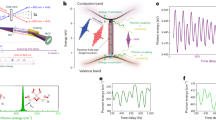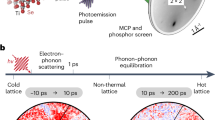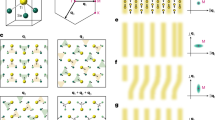Abstract
The macroscopic characteristics of a material are determined by its elementary excitations, which dictate the response of the system to external stimuli. The spectrum of excitations is related to fluctuations in the density–density correlations and is typically measured through frequency-domain neutron1 or X-ray2,3,4 scattering. Time-domain measurements of these correlations could yield a more direct way to investigate the excitations of solids and their couplings both near to and far from equilibrium. Here we show that we can access large portions of the phonon dispersion of germanium by measuring the diffuse scattering from femtosecond X-ray free-electron laser pulses. A femtosecond optical laser pulse slightly quenches the vibrational frequencies, producing pairs of high-wavevector phonons with opposite momenta. These phonons manifest themselves as time-dependent coherences in the displacement correlations5 probed by the X-ray scattering. As the coherences are preferentially created in regions of strong electron–phonon coupling, the time-resolved approach is a natural spectroscopic tool for probing low-energy collective excitations in solids, and their microscopic interactions.
This is a preview of subscription content, access via your institution
Access options
Subscribe to this journal
Receive 12 print issues and online access
$259.00 per year
only $21.58 per issue
Buy this article
- Purchase on SpringerLink
- Instant access to full article PDF
Prices may be subject to local taxes which are calculated during checkout




Similar content being viewed by others
References
Brockhouse, B. N. & Stewart, A. T. Scattering of neutrons by phonons in an aluminum single crystal. Phys. Rev. 100, 756–757 (1955).
Rueff, J-P. & Shukla, A. Inelastic x-ray scattering by electronic excitations under high pressure. Rev. Mod. Phys. 82, 847–896 (2010).
Krisch, M. & Sette, F. in Light Scattering in Solid IX Vol. 108 (eds Cardona, M. & Merlin, R.) 317–370 (Topics in Applied Physics, Springer, 2007).
Abbamonte, P., Finkelstein, K. D., Collins, M. D. & Gruner, S. M. Imaging density disturbances in water with a 41.3-attosecond time resolution. Phys. Rev. Lett. 92, 237401 (2004).
Glauber, R. J. Time-dependent displacement correlations and inelastic scattering by crystals. Phys. Rev. 98, 1692–1698 (1955).
Warren, B. E. X-Ray Diffraction (Dover, 1969).
Sinha, S. K. Theory of inelastic x-ray scattering from condensed matter. J. Phys. Condens. Matter 13, 7511–7523 (2001).
Van Hove, L. Correlations in space and time and born approximation scattering in systems of interacting particles. Phys. Rev. 95, 249–262 (1954).
Trigo, M. et al. Imaging nonequilibrium atomic vibrations with x-ray diffuse scattering. Phys. Rev. B 82, 235205 (2010).
Biswas, R. & Ambegaokar, V. Phonon spectrum of a model of electronically excited silicon. Phys. Rev. B 26, 1980–1988 (1982).
Stampfli, P. & Bennemann, K. H. Theory for the instability of the diamond structure of Si, Ge, and C induced by a dense electron-hole plasma. Phys. Rev. B 42, 7163–7173 (1990).
Zijlstra, E. S., Walkenhorst, J. & Garcia, M. E. Anharmonic noninertial lattice dynamics during ultrafast nonthermal melting of InSb. Phys. Rev. Lett. 101, 135701 (2008).
Hillyard, P. B., Reis, D. A. & Gaffney, K. J. Carrier-induced disordering dynamics in InSb studied with density functional perturbation theory. Phys. Rev. B 77, 195213 (2008).
Slusher, R. E., Hollberg, L. W., Yurke, B., Mertz, J. C. & Valley, J. F. Observation of squeezed states generated by four-wave mixing in an optical cavity. Phys. Rev. Lett. 55, 2409–2412 (1985).
Garrett, G. A., Rojo, A. G., Sood, A. K., Whitaker, J. F. & Merlin, R. Vacuum squeezing of solids: Macroscopic quantum states driven by light pulses. Science 275, 1638–1640 (1997).
Johnson, S. L. et al. Directly observing squeezed phonon states with femtosecond x-ray diffraction. Phys. Rev. Lett. 102, 175503 (2009).
Nation, P. D., Johansson, J. R., Blencowe, M. P. & Nori, F. Stimulating uncertainty: Amplifying the quantum vacuum with superconducting circuits. Rev. Mod. Phys. 84, 1–24 (2012).
Jaskula, J-C. et al. Acoustic analog to the dynamical Casimir effect in a Bose-Einstein condensate. Phys. Rev. Lett. 109, 220401 (2012).
Kiss, T., Janszky, J. & Adam, P. Time evolution of harmonic oscillators with time-dependent parameters: A step-function approximation. Phys. Rev. A 49, 4935–4942 (1994).
Carusotto, I., Balbinot, R., Fabbri, A. & Recati, A. Density correlations and analog dynamical Casimir emission of Bogoliubov phonons in modulated atomic Bose-Einstein condensates. Eur. Phys. J. D 56, 391–404 (2010).
Ruqing, X. & Chiang, T. C. Determination of phonon dispersion relations by x-ray thermal diffuse scattering. Z. Kristallogr. 220, 1009–1016 (2005).
Holt, M. et al. Determination of phonon dispersions from x-ray transmission scattering: The example of silicon. Phys. Rev. Lett. 83, 3317–3319 (1999).
Herman, Frank Lattice vibrational spectrum of germanium. J. Phys. Chem. Solids 8, 405–418 (1959).
Patel, C., Sherman, W. F. & Wilkinson, G. R. Reinvestigation of the lattice dynamics of diamond on the basis of a born-von kármán model. J. Phys. C. Solid State Phys. 17, 6063–6069 (1984).
Jian, W., Kaiming, Z. & Xide, X. Reinvestigation of the TA modes in Ge and Si in Born-von Karman model. Solid State Commun. 86, 731–734 (1993).
Glownia, J. M. et al. Time-resolved pump-probe experiments at the LCLS. Opt. Express 18, 17620–17630 (2010).
Amann, J. et al. Demonstration of self-seeding in a hard-x-ray free-electron laser. Nature Photon. 6, 693–698 (2012).
Harmand, M. et al. Achieving few-femtosecond time-sorting at hard x-ray free-electron lasers. Nature Photon. 7, 215–218 (2013).
Acknowledgements
The authors thank A. Barty, M. Bionta, J. Defever, S. Edstrom, C. Kenney, T. Huber, S. Nelson and K. Ramsey for their experimental assistance. This work was primarily supported by the US Department of Energy (DOE), Office of Basic Energy Sciences (BES) through the Division of Materials Sciences and Engineering under contract DE-AC02-76SF00515. Measurements were carried out at the LCLS at SLAC National Accelerator Laboratory. LCLS is an Office of Science User Facility operated for DOE Office of Science by Stanford University. M.E.K. was supported by the DOE Office of Science Graduate Fellowship Program. G.N. and S.G. were supported by the AMOS program within the Chemical Sciences, Geosciences, and Biosciences Division, DOE, BES. M.F. acknowledges financial support from the Volkswagen Foundation. F.Q. and K.S-T. acknowledge support by the German Research Council (DFG) through the Collaborative Research Center 616 ‘Energy Dissipation at Surfaces’. J.L. was supported by the Swedish Science Council (VR) A.H. was supported by AWE. J.S.W. is grateful for support from the UK EPSRC under grant no. EP/H035877/1.
Author information
Authors and Affiliations
Contributions
D.A.R. and M.T. conceived the experiment and the framework for the data interpretation, M.T. and M.F. analysed the data, K.G., S.F. and J.S.W. contributed to data interpretation, C.U. and G.W. prepared Bi samples for the precise timing overlap between the X-ray and optical pulses, and M.T. and D.A.R. wrote the manuscript with input from all other authors. The experiment was carried out by M.T., M.F., J.C., M.P.J., M.C., D.M.F., K.G, S.G., A.H., S.L.J., M.E.K., J.L., H.L., A.M.L., G.N., F.Q., K.S-T., D.Z. and D.A.R. The X-ray pump–probe instrument was operated by M.C. D.M.F., H.L. and D.Z.
Corresponding authors
Ethics declarations
Competing interests
The authors declare no competing financial interests.
Supplementary information
Supplementary Information
Supplementary Information (PDF 575 kb)
Supplementary Movie
Supplementary Movie 1 (MP4 1314 kb)
Supplementary Movie
Supplementary Movie 2 (MP4 9680 kb)
Rights and permissions
About this article
Cite this article
Trigo, M., Fuchs, M., Chen, J. et al. Fourier-transform inelastic X-ray scattering from time- and momentum-dependent phonon–phonon correlations. Nature Phys 9, 790–794 (2013). https://doi.org/10.1038/nphys2788
Received:
Accepted:
Published:
Issue date:
DOI: https://doi.org/10.1038/nphys2788
This article is cited by
-
Quenched lattice fluctuations in optically driven SrTiO3
Nature Materials (2024)
-
Ultrafast lattice disordering can be accelerated by electronic collisional forces
Nature Physics (2023)
-
Ultrafast optical melting of trimer superstructure in layered 1T′-TaTe2
Communications Physics (2021)
-
Four-dimensional imaging of lattice dynamics using ab-initio simulation
npj Computational Materials (2021)
-
Double-pulse speckle contrast correlations with near Fourier transform limited free-electron laser light using hard X-ray split-and-delay
Scientific Reports (2020)



